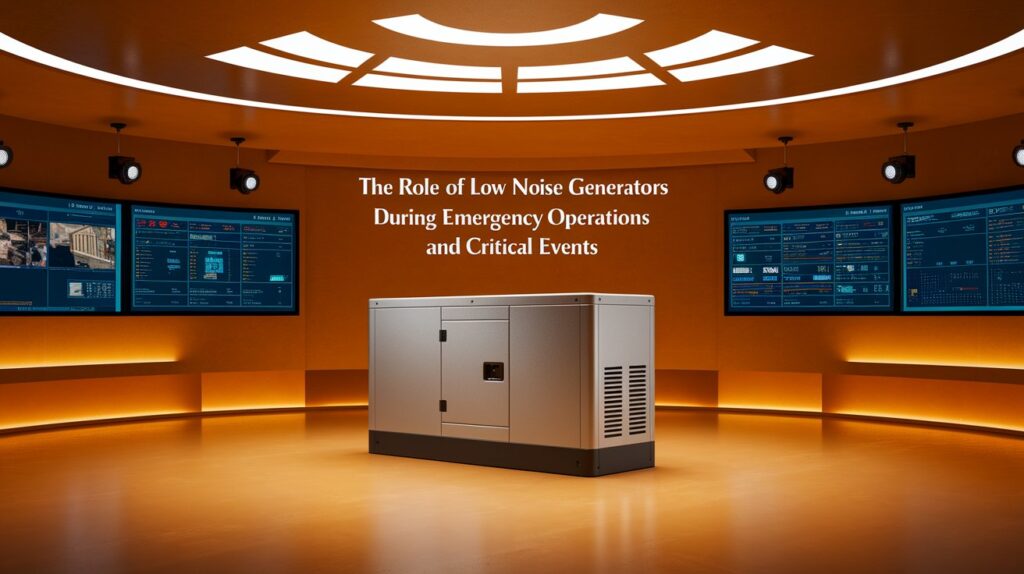During emergencies and large public events, dependable electricity is crucial. Any disruption can impact safety, communication, and coordination. Standard generators, while effective, often produce noise that complicates response efforts. Quiet-running units offer a practical solution, supporting essential equipment without adding to the surrounding stress or confusion.
The Importance of Noise Control in Sensitive Environments
Power reliability and clear communication are essential in critical spaces like hospitals, emergency shelters, and mobile command units. Excessive background noise can hinder coordination, especially during high-pressure situations. Sound-attenuated units are often used by councils in commercial cities to maintain calm in temporary community shelters while delivering steady energy to essential systems.
Reduced noise levels improve audibility for medical staff, responders, and displaced individuals. This is particularly important in areas with elderly populations or when schools are converted into care hubs. The quiet operation creates a more stable environment, helping teams manage tasks efficiently while meeting strict planning standards across both regional and urban areas.
Use Cases in Emergency Services
Low-noise generators play a major role during natural disasters and mobile service deployment. Emergency crews rely on mobile electricity for communication units, water pumps, and portable medical stations. These units are commonly used during:
- Bushfire relief zones requiring temporary accommodation
- Flooded areas where water treatment and lighting systems are essential
- Coastal regions impacted by storms or cyclones require mobile command centers
In many locations, agencies prefer lower sound units when operating near suburban neighborhoods during night hours. This allows for emergency work to continue without disturbing residents or adding stress to recovery zones.
Role in Event Management and Public Safety
These generators are increasingly used in public event settings nationwide. Street festivals, concerts, and seasonal markets often take place near residential or commercial areas, where managing noise is essential. Event coordinators rely on low-noise systems to operate main-stage sound setups, temporary lighting, and food vendor equipment such as refrigeration and heating units.
Many councils enforce strict noise regulations during evening and weekend hours. Quiet generators help meet these requirements while keeping event systems fully functional. From safety lighting to public address systems, these units support essential functions without causing disruption, helping create smooth and well-managed public experiences.
Benefits for Local Councils and Urban Deployments
Urban planning often includes strategies for emergency readiness, especially in high-density locations. Councils maintain backup systems to support traffic signals, communication tools, and safety centers during outages or disruptions. Compact, low-sound generators are commonly deployed to run health tents during extreme heat or to provide electricity for temporary housing units following local infrastructure issues.
These units are also used for detour lighting at busy intersections during construction. Their quiet operation allows placement near populated areas without adding noise disturbances. Designed for mobility, many are mounted on trailers or enclosed in weather-resistant casings, making them easy to deploy wherever support is needed most.
Selecting an Appropriate Quiet Generator
Selection depends on site demands and expected load requirements. In emergency and event settings, equipment must be ready for fast setup and consistent performance. Some factors to consider:
- Sound-attenuated canopies that shield engine and exhaust noise
- Fuel efficiency to support extended use with minimal refueling
- Runtime capacity to match the length of the operation
- Mobility features for faster relocation and storage
- Hybrid generator options for combining solar or battery assist
Sensitive Settings and Rapid Response
Emergency operations now require equipment that works reliably in both urban and rural environments. A steady power source is essential for mobile command posts, lighting, and communication systems. Such generators allow these functions to continue without disrupting nearby areas. Their low sound output supports focused coordination in shelters, medical zones, and public safety hubs.
Low-noise generators are now part of many council and agency plans. They help maintain essential services during evacuations, night operations, and community events. These units reduce noise impact while ensuring critical systems stay active. Careful planning ensures the right equipment is ready when conditions shift quickly.

